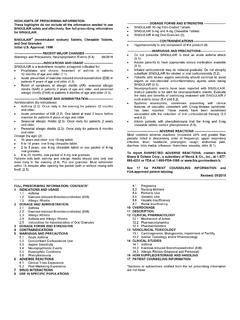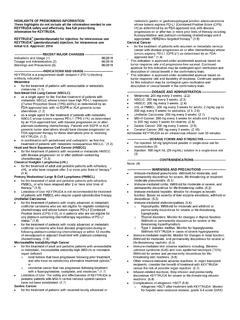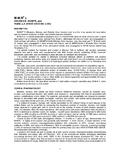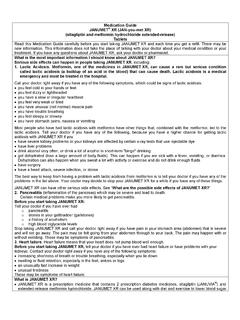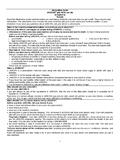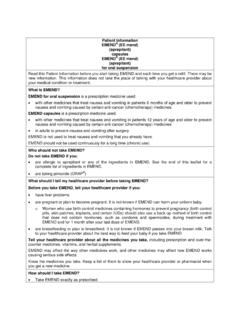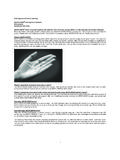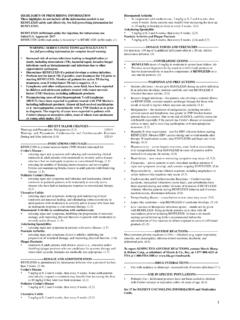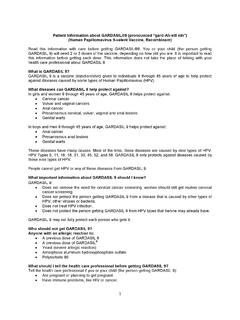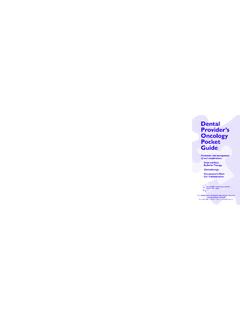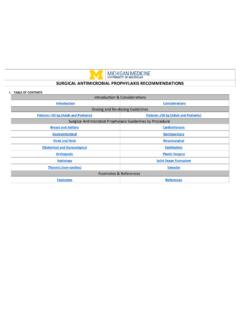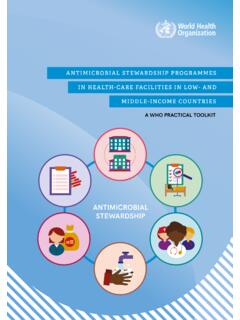Transcription of INVANZ. INVANZ in patients receiving β - Merck & Co.
1 HIGHLIGHTS OF PRESCRIBING INFORMATIONT hese highlights do not include all the information needed to use INVANZ safely and effectively. See full prescribing information for (ertapenem for injection), for intravenous or intramuscular useInitial Approval: 2001----------------------------INDICATI ONS AND USAGE---------------------------- INVANZ is a penem antibacterial indicated in adult patients and pediatric patients (3 months of age and older) for the treatment of the following moderate to severe infections caused by susceptible bacteria: Complicated intra-abdominal infections. ( ) Complicated skin and skin structure infections, including diabetic foot infections without osteomyelitis. ( ) Community-acquired pneumonia. ( ) Complicated urinary tract infections including pyelonephritis.
2 ( ) Acute pelvic infections including postpartum endomyometritis, septic abortion and post- surgical gynecologic infections. ( ) INVANZ is indicated in adults for the prophylaxis of surgical site infection following elective colorectal surgery. ( )To reduce the development of drug-resistant bacteria and maintain the effectiveness of INVANZ and other antibacterial drugs, INVANZ should be used only to treat or prevent infections that are proven or strongly suspected to be caused by susceptible bacteria. ( )-----------------------DOSAGE AND ADMINISTRATION -----------------------Do not mix or co-infuse INVANZ with other medications. Do not use diluents containing dextrose ( D glucose). ( ) INVANZ should be infused over 30 minutes in both the Treatment and Prophylactic regimens.
3 ( )Dosing considerations should be made in adults with advanced or end-stage renal impairment and those on hemodialysis. ( , )Treatment regimen: Adults and pediatric patients 13 years of age and older. The dosage should be 1 gram once a day intravenously or intramuscularly. ( ) patients 3 months to 12 years of age should be administered 15 mg/kg twice daily (not to exceed 1 g/day intravenously or intramuscularly.) ( ) Intravenous infusion may be administered in adults and pediatrics for up to 14 days or intramuscular injection for up to 7 days. ( ) prophylaxis regimen for adults: 1 gram single dose given 1 hour prior to elective colorectal surgery. ( )---------------------DOSAGE FORMS AND STRENGTHS --------------------- For injection: Single-dose vial 1 gram.
4 (3)-------------------------------CONTRA INDICATIONS----------------------------- -- Known hypersensitivity to product components or anaphylactic reactions to -lactams. (4) Due to the use of lidocaine HCl as a diluent, INVANZ administered intramuscularly is contraindicated in patients with a known hypersensitivity to local anesthetics of the amide type. (4)-----------------------WARNINGS AND PRECAUTIONS ----------------------- Serious hypersensitivity (anaphylactic) reactions have been reported in patients receiving -lactams. ( ) Seizures and other central nervous system adverse experiences have been reported during treatment. ( ) Co-administration of INVANZ with valproic acid or divalproex sodium reduces the serum concentration of valproic acid potentially increasing the risk of breakthrough seizures.
5 ( ) Clostridioides difficile-associated diarrhea (ranging from mild diarrhea to fatal colitis): Evaluate if diarrhea occurs. ( ) Caution should be taken when administering INVANZ intramuscularly to avoid inadvertent injection into a blood vessel. ( ) ------------------------------ADVERSE REACTIONS ------------------------------Adults:The most common adverse reactions ( 5%) in patients treated with INVANZ , including those who were switched to therapy with an oral antimicrobial, were diarrhea, nausea, headache and infused vein complication. ( ) In the prophylaxis indication the overall adverse experience profile was generally comparable to that observed for ertapenem in other clinical trials.
6 ( )Pediatrics:Adverse reactions in this population were comparable to adults. The most common adverse reactions ( 5%) in pediatric patients treated with INVANZ , including those who were switched to therapy with an oral antimicrobial, were diarrhea, vomiting and infusion site pain. ( )To report SUSPECTED ADVERSE REACTIONS, contact Merck Sharp & Dohme Corp., a subsidiary of Merck & Co., Inc., at 1-877-888-4231 or FDA at 1-800-FDA-1088 or INTERACTIONS---------------------------- --- Co-administration with probenecid inhibits the renal excretion of ertapenem and is therefore not recommended. ( ) The concomitant use of ertapenem and valproic acid/divalproex sodium is generally not recommended. Anti-bacterials other than carbapenems should be considered to treat infections in patients whose seizures are well controlled on valproic acid or divalproex sodium.
7 ( , )-----------------------USE IN SPECIFIC POPULATIONS ----------------------- Renal Impairment: Dose adjustment is necessary, if creatinine clearance is 30 mL/ m2. ( , , )See 17 for PATIENT COUNSELING INFORMATION. Revised: 06/2021 FULL PRESCRIBING INFORMATION: CONTENTS*1 INDICATIONS AND Intra-Abdominal Infections Skin and Skin Structure Infections, Including Diabetic Foot Infections without Community Acquired Pneumonia Urinary Tract Infections Including Acute Pelvic Infections Including Postpartum Endomyometritis, Septic Abortion and Post- surgical Gynecologic of surgical Site Infection Following Elective Colorectal AND for Use in All Regimen in with Renal on with Hepatic and Reconstitution for Administration3 DOSAGE FORMS AND STRENGTHS4 CONTRAINDICATIONS5 WARNINGS AND with Valproic difficile-Associated Diarrhea (CDAD)
8 With Intramuscular of Drug-Resistant Tests6 ADVERSE Trials Post-Marketing Laboratory Changes in Clinical Trials7 DRUG Acid8 USE IN SPECIFIC with Renal with Hepatic Impairment 210 OVERDOSAGE11 DESCRIPTION12 CLINICAL Mechanism of Microbiology13 NONCLINICAL Carcinogenesis, Mutagenesis, Impairment of Animal Toxicology and/or Pharmacology14 CLINICAL Pediatric Patients16 HOW SUPPLIED/STORAGE AND How Storage and Handling17 PATIENT COUNSELING Instructions for patients *Sections or subsections omitted from the full prescribing information are not PRESCRIBING INFORMATION1 INDICATIONS AND USAGE Intra-Abdominal InfectionsINVANZ is indicated for the treatment of adult patients and pediatric patients (3 months of age and older)
9 With complicated intra-abdominal infections due to Escherichia coli, Clostridium clostridioforme, Eubacterium lentum, Peptostreptococcus species, Bacteroides fragilis, Bacteroides distasonis, Bacteroides ovatus, Bacteroides thetaiotaomicron, or Bacteroides Skin and Skin Structure Infections, Including Diabetic Foot Infections without OsteomyelitisINVANZ is indicated for the treatment of adult patients and pediatric patients (3 months of age and older) with complicated skin and skin structure infections, including diabetic foot infections without osteomyelitis due to Staphylococcus aureus (methicillin susceptible isolates only), Streptococcus agalactiae, Streptococcus pyogenes, Escherichia coli, Klebsiella pneumoniae, Proteus mirabilis, Bacteroides fragilis, Peptostreptococcus species, Porphyromonas asaccharolytica, or Prevotella bivia.
10 INVANZ has not been studied in diabetic foot infections with concomitant osteomyelitis [see Clinical Studies (14)]. Acquired PneumoniaINVANZ is indicated for the treatment of adult patients and pediatric patients (3 months of age and older) with community acquired pneumonia due to Streptococcus pneumoniae (penicillin susceptible isolates only) including cases with concurrent bacteremia, Haemophilus influenzae (beta-lactamase negative isolates only), or Moraxella Urinary Tract Infections Including PyelonephritisINVANZ is indicated for the treatment of adult patients and pediatric patients (3 months of age and older) with complicated urinary tract infections including pyelonephritis due to Escherichia coli, including cases with concurrent bacteremia, or Klebsiella Pelvic Infections Including Postpartum Endomyometritis, Septic Abortion and Post- surgical Gynecologic InfectionsINVANZ is indicated for the treatment of adult patients and pediatric patients (3 months of age and older)
